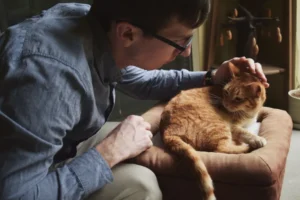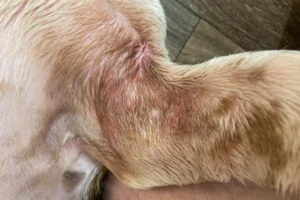Are you noticing that your cat’s eyelids are swollen? In this blog post, we will explore the potential reasons behind this concerning issue and provide you with valuable insights on how to address it.
Understanding the Causes of Swollen Eyelids in Cats
Swollen eyelids in cats can be caused by a variety of factors, with allergies being a common culprit. Just like humans, cats can have allergic reactions to various substances in their environment, such as pollen, dust, or certain foods. These allergies can lead to inflammation and swelling of the eyelids, causing discomfort for your furry friend.
Infections are another potential cause of swollen eyelids in cats. Bacterial, viral, or fungal infections can affect the eyes and surrounding tissues, leading to swelling and redness. It’s essential to keep an eye out for any signs of discharge or unusual behavior in your cat’s eyes, as these could indicate an infection that requires prompt treatment.
In some cases, swollen eyelids in cats may be a symptom of an underlying health condition, such as conjunctivitis or uveitis. These conditions can cause inflammation in the eye and surrounding areas, including the eyelids. If your cat’s swollen eyelids are persistent or accompanied by other symptoms like eye discharge or squinting, it’s crucial to consult your veterinarian for a proper diagnosis and treatment plan.
Signs and Symptoms to Look Out for
When monitoring your cat for swollen eyelids, it’s important to watch out for specific signs and symptoms that could indicate a problem. Redness or swelling in one or both eyelids is a clear indication that something is amiss. Your cat may also exhibit excessive blinking or rubbing of their eyes, signaling discomfort or pain.
Keep an eye out for any discharge coming from your cat’s eyes, as this could be a sign of an infection or underlying health issue. Additionally, if you notice your cat avoiding light or squinting, it could indicate sensitivity in the eyes and the need for immediate attention.
If your cat is displaying any of these signs or symptoms, it’s essential to schedule a visit to the vet promptly. A professional assessment can help determine the root cause of the swollen eyelids and ensure your cat receives the necessary treatment to alleviate their discomfort.
Remember, your furry companion relies on you to take care of their health and well-being. By staying vigilant and proactive in monitoring their symptoms, you can ensure that any issues with swollen eyelids are addressed swiftly and effectively.
How to Properly Care for Your Cat’s Swollen Eyelids
If your furry feline friend is dealing with swollen eyelids, it’s essential to take proper care to ensure they recover comfortably. To start, gently clean their eyes with a soft, damp cloth to remove any debris or discharge. Avoid using harsh chemicals or products not specifically formulated for cats.
Keep an eye on your cat’s behavior – if they seem in pain, have difficulty opening their eyes, or if the swelling persists for more than a day or two, it’s time to consult a vet. Regularly wiping their eyes clean can prevent infections and soothe irritation.
Watch out for any changes in their eyes such as redness, discharge, excessive tearing, or squinting. Monitoring your cat’s eye health can help catch any issues early. Remember, your pet’s comfort is a top priority, so be diligent in your care routine.
Additional Tip: To remove crusty residue around your cat’s eyes, use a vet-approved saline solution or a gentle eye wipe specially designed for pets.
When to Seek Veterinary Care
While caring for your cat’s swollen eyelids at home is important, there are certain situations where professional veterinary care is necessary. If your cat’s eyelids are extremely red, swollen, or if they are experiencing eye discharge or sensitivity to light, it’s time to schedule a vet visit.
Persistent swelling that does not improve with home care, along with signs of pain or distress, warrant immediate veterinary attention . Cats are known for hiding discomfort, so any noticeable changes in their behavior should be taken seriously.
Remember, your vet can provide specialized care and treatments tailored to your cat’s specific eye condition, ensuring a speedy recovery. It’s better to err on the side of caution and seek expert help when needed.
Don’t delay if you notice concerning symptoms – acting promptly can prevent further complications and discomfort for your beloved pet.
Treatment Options Available for Swollen Eyelids
If you notice your cat’s eyelids are swollen, it’s essential to seek veterinary care promptly to identify the underlying cause. Treatment options for swollen eyelids in cats may vary depending on the specific diagnosis but commonly include:
Medication: Your vet may prescribe antibiotics, anti-inflammatory drugs, or antihistamines to reduce swelling and treat any infections.
Warm Compress: Applying a warm compress to your cat’s eyes can help reduce inflammation and promote drainage if there is a buildup of fluid.
Surgical Interventions: In more severe cases, your vet may recommend surgical procedures to address issues such as eyelid tumors or abnormalities causing the swelling.
Dietary Changes: In some instances, dietary adjustments may be necessary if food allergies are contributing to the swelling.
Remember, always follow your vet’s recommendations for treatment and monitor your cat’s progress closely. Swift and appropriate treatment can help your feline friend recover quickly from swollen eyelids.
Preventative Measures to Keep Your Cat’s Eyes Healthy
Keeping your cat’s eyes healthy is crucial to prevent future occurrences of swollen eyelids. Here are some preventative measures to consider:
Regular Eye Exams: Schedule regular check-ups with your vet to monitor your cat’s eye health and catch any issues early.
Clean Environment: Keep your cat’s living area clean to reduce the risk of eye infections that can lead to swollen eyelids.
Proper Nutrition: Ensure your cat is eating a balanced diet to support overall health, including eye health.
Avoid Irritants: Keep irritants such as dust and smoke away from your cat to prevent eye irritation and swelling.
By taking proactive steps to care for your cat’s eyes, you can help maintain their eye health and reduce the likelihood of swollen eyelids in the future. Your furry friend will thank you for it!
Interesting Facts About Feline Eye Health
Did you know that cats have a third eyelid called the nictitating membrane that helps protect their eyes? This extra layer of defense can sometimes become swollen due to various factors like allergies, infections, or injuries. Additionally, cats have larger corneas and pupils compared to humans, allowing them to see better in dim light. Keeping an eye on your cat’s eye health is crucial for their overall well-being.
Tips for Creating a Cat-Friendly Environment
- Regular Vet Check-ups: Schedule annual eye check-ups with your vet to catch any issues early.
- Proper Nutrition: A balanced diet rich in vitamins and minerals can help maintain your cat’s eye health.
- Clean Environment: Keep your cat’s living area clean to prevent irritants that could cause eye irritation.
- Gentle Cleaning: If your cat’s eyes appear swollen, use a clean damp cloth to gently wipe away any discharge.
- Avoid Harmful Chemicals: Keep cleaning products and chemicals away from your cat’s reach to avoid eye injuries.
Remember, creating a cat-friendly environment goes beyond just toys and treats; it involves ensuring their eye health is also a top priority. Your feline friend will thank you for the care and attention you provide.
Alex, a passionate animal lover, has experience in training and understanding animal behavior. As a proud pet parent to two dogs and three cats, he founded AnimalReport.net to share insights from animal experts and expand his knowledge of the animal kingdom.









